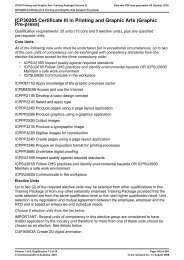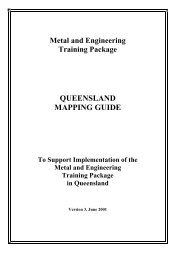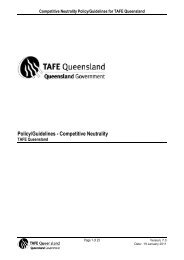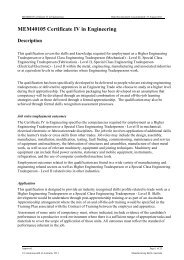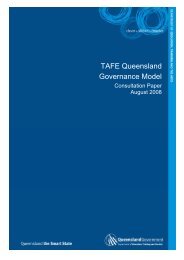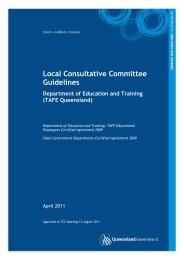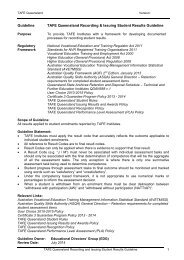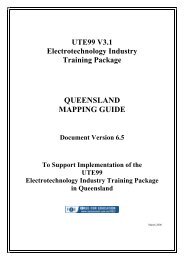The Crux of the Matter - Training Queensland - Queensland ...
The Crux of the Matter - Training Queensland - Queensland ...
The Crux of the Matter - Training Queensland - Queensland ...
Create successful ePaper yourself
Turn your PDF publications into a flip-book with our unique Google optimized e-Paper software.
Tip 8: <strong>The</strong> ACSF and LLN levels<br />
Once you have established a list <strong>of</strong> LLN activities<br />
from analysis <strong>of</strong> <strong>the</strong> <strong>Training</strong> Package unit <strong>of</strong><br />
competency or accredited course modules,<br />
you’ll need to give <strong>the</strong>se activities a level <strong>of</strong><br />
difficulty. This enables consistent and meaningful<br />
judgements about <strong>the</strong> level <strong>of</strong> reading, writing, oral<br />
communication and numeracy in <strong>the</strong> qualification or<br />
course to be made.<br />
<strong>The</strong> nationally recognised scale for indicating LLN<br />
in VET is <strong>the</strong> ACSF: a mechanism for reporting adult<br />
English LLN indicators <strong>of</strong> competence. <strong>The</strong> ACSF<br />
provides a means <strong>of</strong> commenting on five different<br />
levels <strong>of</strong> complexity (level 1, least difficult to level<br />
5, most difficult) across <strong>the</strong> different macro skills <strong>of</strong><br />
reading, writing, oral communication, numeracy and<br />
learning.<br />
Defining <strong>the</strong> levels for each LLN activity<br />
1. Examine <strong>the</strong> ACSF levels and make an estimation<br />
<strong>of</strong> <strong>the</strong> level <strong>of</strong> each macro skill task. When<br />
determining approximate LLN levels, you’ll need<br />
look separately at each <strong>of</strong> <strong>the</strong> macro skills – reading,<br />
writing, oral communication and numeracy.<br />
Tips<br />
Tip 7: Locating LLN in <strong>Training</strong><br />
Package units <strong>of</strong> competency<br />
or accredited course modules.<br />
Page 25.<br />
Information sheets<br />
Information sheet 2: Identifying<br />
<strong>the</strong> LLN skills <strong>of</strong> <strong>the</strong> learner.<br />
Page 65.<br />
Resources<br />
Resources: Legislation, policy<br />
and guidelines. Australian Core<br />
Skills Framework website<br />
A qualification or course cannot have an overall<br />
ACSF level <strong>of</strong> complexity. Complexity may vary<br />
between <strong>the</strong> different macro skills. For example, in<br />
<strong>the</strong> unit CPCCSC2002A Erect and dismantle basic<br />
scaffolding, from <strong>the</strong> CPC08 Construction, Plumbing<br />
and Services Integrated Framework, <strong>the</strong>re is limited<br />
writing at level 2 (basic workplace notes and filling<br />
out checklists) but high levels <strong>of</strong> numeracy at level<br />
4 (use a range <strong>of</strong> algebraic formulae and calculating<br />
tools to solve work-based problems).<br />
<strong>The</strong> full use <strong>of</strong> <strong>the</strong> ACSF requires specialist<br />
knowledge and experience in <strong>the</strong> areas <strong>of</strong> LLN<br />
acquisition and application. If you are a vocational<br />
trainer you may benefit from an overview session<br />
with a LLN specialist who can explain <strong>the</strong> basic<br />
concepts and practical use <strong>of</strong> <strong>the</strong> tools in this<br />
resource.<br />
Examine <strong>the</strong> list from each macro skill and decide<br />
which tasks are <strong>the</strong> most difficult before going on to<br />
consider <strong>the</strong> complexity and to assign levels for that<br />
qualification. In many cases it will be obvious which<br />
tasks are more difficult. But it may be worth checking<br />
<strong>the</strong>se thoughts with a couple <strong>of</strong> workers from<br />
industry who can give a ‘grassroots’ perspective.<br />
For example, a vocational trainer <strong>of</strong> scaffolding has<br />
come up with <strong>the</strong> following items for reading: read<br />
safety signs and symbols; read own time sheets;<br />
read work plans and technical specifications and<br />
excerpts from <strong>the</strong> QLD Codes <strong>of</strong> Practice. <strong>The</strong> first two<br />
tasks involving signs and timesheets are likely to be<br />
less difficult, especially over time, as <strong>the</strong> learner will<br />
become familiar with <strong>the</strong> texts.<br />
30 <strong>The</strong> <strong>Crux</strong> <strong>of</strong> <strong>the</strong> <strong>Matter</strong> - Language, Literacy and Numeracy and Vocational Education and <strong>Training</strong>





